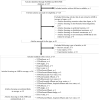Review of Antimicrobial Resistance in Wastewater in Japan: Current Challenges and Future Perspectives
- PMID: 35884103
- PMCID: PMC9312076
- DOI: 10.3390/antibiotics11070849
Review of Antimicrobial Resistance in Wastewater in Japan: Current Challenges and Future Perspectives
Abstract
Antimicrobial resistance (AMR) circulates through humans, animals, and the environments, requiring a One Health approach. Recently, urban sewage has increasingly been suggested as a hotspot for AMR even in high-income countries (HICs), where the water sanitation and hygiene infrastructure are well-developed. To understand the current status of AMR in wastewater in a HIC, we reviewed the epidemiological studies on AMR in the sewage environment in Japan from the published literature. Our review showed that a wide variety of clinically important antibiotic-resistant bacteria (ARB), antibiotic resistance genes (ARGs), and antimicrobial residues are present in human wastewater in Japan. Their concentrations are lower than in low- and middle-income countries (LMICs) and are further reduced by sewage treatment plants (STPs) before discharge. Nevertheless, the remaining ARB and ARGs could be an important source of AMR contamination in river water. Furthermore, hospital effluence may be an important reservoir of clinically important ARB. The high concentration of antimicrobial agents commonly prescribed in Japan may contribute to the selection and dissemination of AMR within wastewater. Our review shows the importance of both monitoring for AMR and antimicrobials in human wastewater and efforts to reduce their contamination load in wastewater.
Keywords: Japan; antibiotic resistance genes; antibiotic-resistant bacteria; one health approach; residual antibiotics; sewage treatment plant; wastewater; water environment.
Conflict of interest statement
The authors declare no conflict of interest.
Figures
References
-
- O’Neill J. Tackling Drug-Resistant Infections Globally: Final Report and Recommendations. The Review on Antimicrobial Resistance. [(accessed on 19 May 2022)]. Available online: https://amr-review.org/sites/default/files/160518_Final%20paper_with%20c....
-
- Nadimpalli M.L., Marks S.J., Montealegre M.C., Gilman R.H., Pajuelo M., Saito M., Tsukayama P., Njenga S.M., Kiiru J., Swarthout J., et al. Urban informal settlements as hotspots of antimicrobial resistance and the need to curb environmental transmission. Nat. Microbiol. 2020;5:787–795. doi: 10.1038/s41564-020-0722-0. - DOI - PubMed
Publication types
Grants and funding
LinkOut - more resources
Full Text Sources


